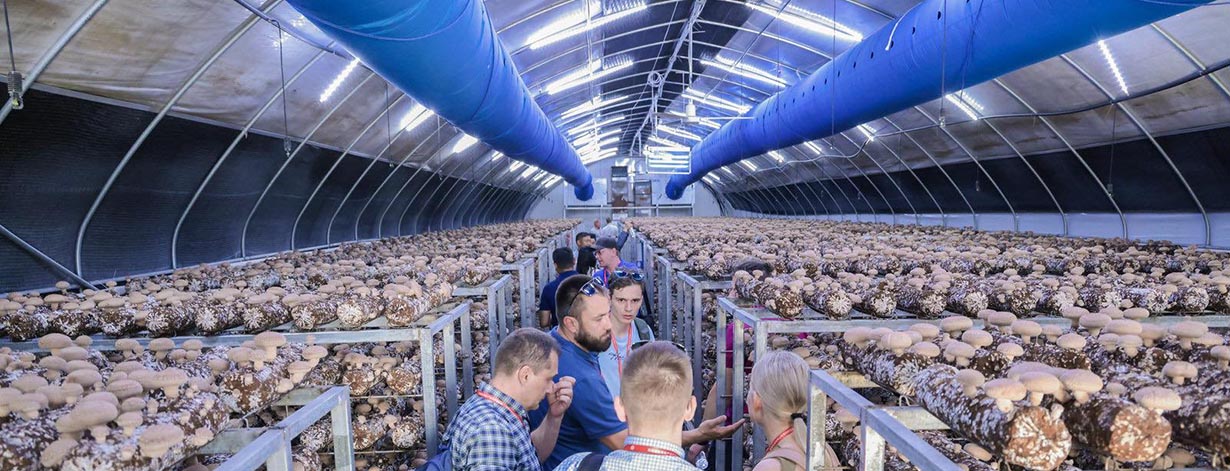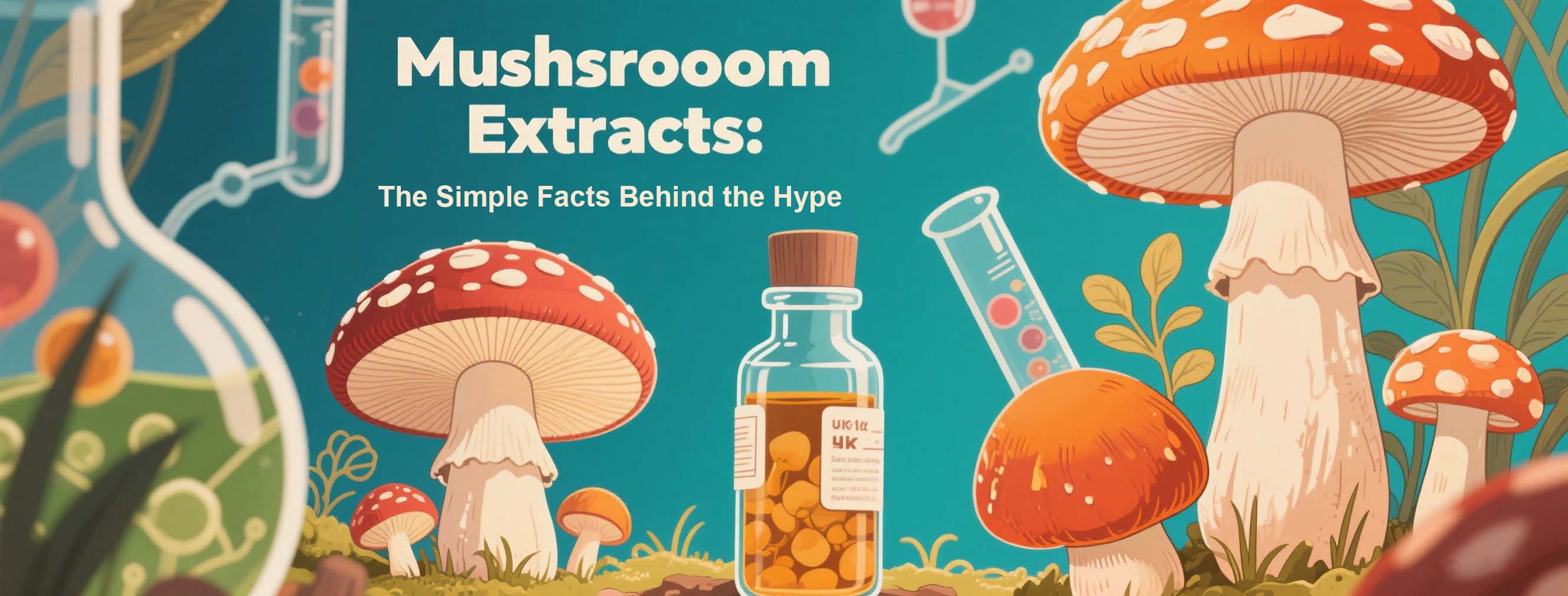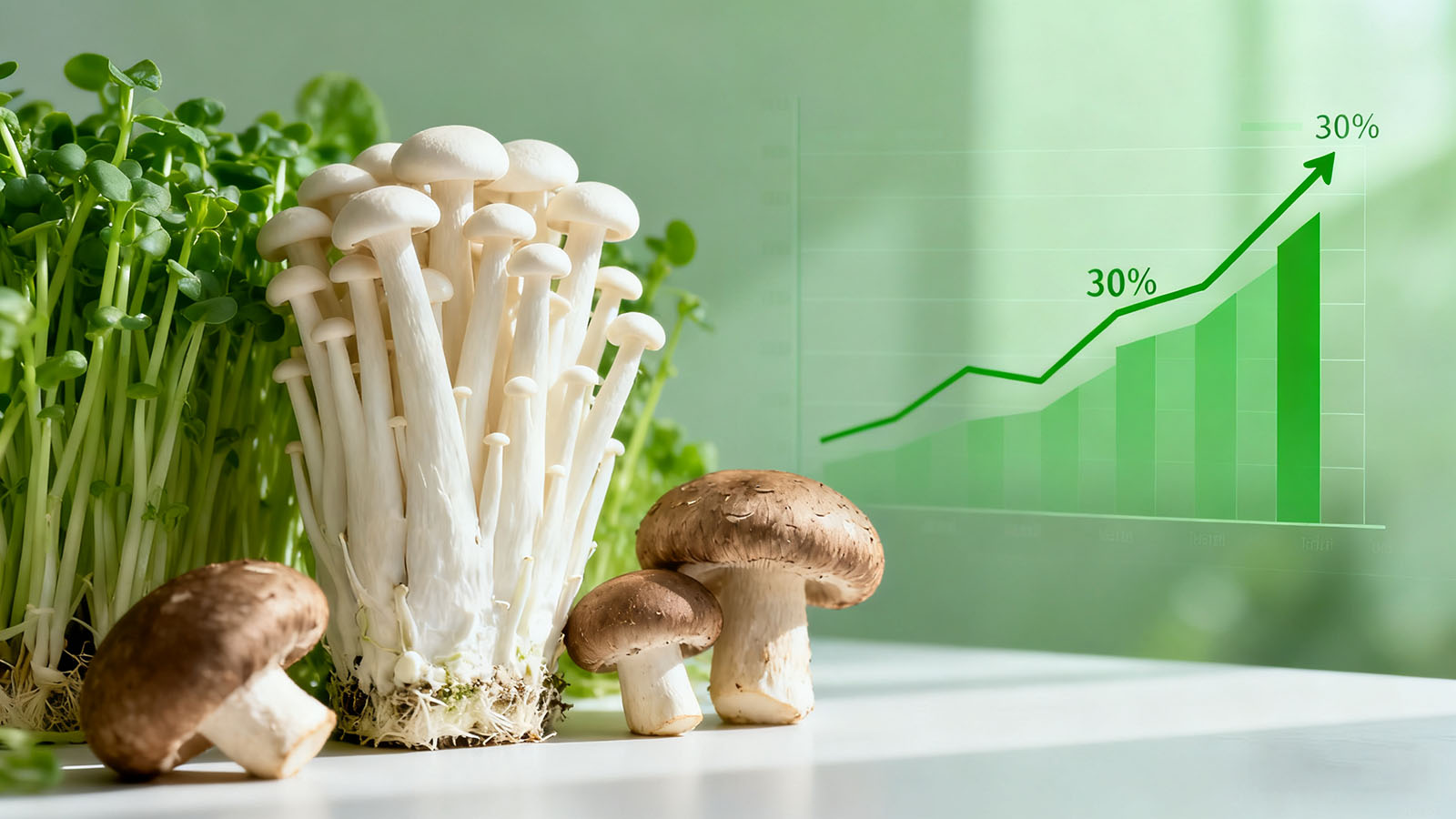
In the European edible fungi landscape, the German mushroom market holds a significant position. In recent years, with the increasing health awareness among Germans, the demand for nutrient-rich mushrooms has been steadily rising. Whether in home kitchens, restaurant kitchens, or food processing workshops, mushrooms are becoming increasingly common. Given the robust development and complex dynamics of the German mushroom market, compiling the "Germany Mushroom Market Guide" is particularly necessary. This guide will comprehensively analyze the current state of the German mushroom market, delve into future trends, and provide a detailed analysis of the challenges faced, offering valuable insights for industry practitioners and investors.
The German mushroom market is experiencing vigorous growth, with its market size expected to reach $2.4077 billion by 2030, with a compound annual growth rate (CAGR) of 9.9% from 2024 to 2030. In terms of production, Germany's total edible mushroom output in 2021 was 83,800 tons, with button mushrooms dominating, accounting for 97% of the total production. Oyster mushrooms, shiitake mushrooms, and other specialty mushrooms make up the remaining portion. The cultivation area for edible mushrooms in 2021 increased by 6% year-on-year to 379 hectares, with 13% of the cultivation area achieving full factory production. Germany's edible mushrooms are mainly produced in nine states, with Lower Saxony and North Rhine-Westphalia being the most important production regions, with cultivation areas of 186 hectares and 70 hectares, respectively.
2. ConsumptionFrom a consumption perspective, Germans have a high preference for mushrooms, and the consumer market is quite active, with noticeable demand growth.
(1) Household ConsumptionWith the increasing popularity of healthy eating in Germany, mushrooms, known for their high protein, low fat, and rich vitamin and mineral content, have become a staple on German family dining tables. Market research data shows that over the past few years, household purchases of mushrooms in Germany have steadily increased, with an annual growth rate of 3% - 5%. Consumers are no longer satisfied with just common button mushrooms; their willingness to purchase specialty mushrooms like oyster mushrooms, shiitake mushrooms, and king oyster mushrooms is also growing, prompting supermarkets and farmers' markets to continuously expand their mushroom offerings.
(2) Food Service IndustryGermany's food service industry is thriving, with a large number of restaurants and cafes. Mushrooms, as a versatile ingredient, are widely used in various dishes such as mushroom soup, mushroom pizza, and mushroom pasta. As consumers demand higher quality and taste, food service businesses are paying more attention to ingredient selection, with fresh, high-quality mushrooms becoming their top choice. In recent years, the number of new restaurants in Germany has been increasing year by year, driving up the demand for mushrooms and further boosting market growth. Industry estimates suggest that the food service industry's demand for mushrooms is growing at an annual rate of 6% - 8%.
(3) Food Processing IndustryThe food processing industry is a significant demand driver in the German mushroom market. Mushrooms are processed into various products such as canned mushrooms, mushroom sauces, and dehydrated mushrooms, which not only meet domestic demand but are also exported to other countries. With advancements in food processing technology and the growing consumer preference for convenient foods, food processing companies are continuously increasing their purchases of mushrooms. For example, some well-known food processing companies are expanding their production lines for canned mushrooms annually to meet market demand for different specifications and flavors, driving the German mushroom market to grow at an annual rate of 5% - 7%.
In terms of variety preferences, button mushrooms are a popular choice due to their delicious taste and wide application. At the same time, with the rise of healthy eating trends, the demand for organic mushrooms is gradually increasing. In Germany, 9% of button mushrooms are organically produced, while the organic rate for other mushrooms is 51%.
3. Market Trends(1) Raw Material Supply ChallengesCurrently, the German mushroom industry faces challenges in raw material supply. On one hand, poor grain harvests in many regions have led to a shortage of straw, an essential raw material for mushroom cultivation. On the other hand, the supply of horse and chicken manure is becoming increasingly difficult as these materials are being used for non-agricultural purposes. Additionally, by 2030, peat used in commercial horticulture will be replaced, which will significantly impact mushroom cultivation. Peat is applied as a casing layer on the substrate and is crucial for mushroom fruiting body formation. Although alternatives have been sought for years, no viable replacement in terms of quantity and quality has been found.
(2) Sustainability DemandsWith increasing environmental awareness, the German mushroom market is placing greater emphasis on sustainability. From a cultivation perspective, growers are exploring more environmentally friendly cultivation techniques and materials to reduce environmental impact. On the product side, consumer demand for sustainably produced mushroom products is growing, prompting companies to adopt greener production methods, such as reducing chemical pesticide use and improving resource efficiency.
(3) Technological InnovationTo address raw material supply issues and meet market demand, technological innovation is key. Factory production technologies are continuously advancing, with precise control over environmental factors such as temperature, humidity, and light to improve mushroom yield and quality. At the same time, researchers are actively developing new cultivation substrates and strains to adapt to market changes, such as finding new substrates to replace peat and cultivating more resilient, higher-yielding mushroom varieties.
(4) Import Dependence and Market CompetitionGermany is a major mushroom consumer market in Europe, and its domestic production cannot fully meet demand, leading to a reliance on mushroom imports. Poland and the Netherlands are Germany's primary sources of mushroom imports. Poland exports a significant amount of button mushrooms to Germany, with exports accounting for 90% of its total production. The Netherlands, with its advanced edible fungi industry, is also an important supplier to Germany. Domestically, competition is fierce among growers and distributors of different scales. Large enterprises have advantages in cost and quality due to advanced technologies and economies of scale, while smaller enterprises compete through unique products and personalized services.
4. Population Engaged in the Mushroom Industry in GermanyAs of December 2023, the population engaged in the mushroom industry in Germany is as follows:
(1) Population SizeTotal Workforce: Approximately 5,000 to 7,000 people are employed in the German mushroom industry, including full-time and seasonal workers.
Seasonal Workers: About 30% to 40% are seasonal workers, primarily from Eastern European countries such as Poland, Romania, and Bulgaria.
(2) Regional DistributionNorth Rhine-Westphalia (NRW): This state is the core region for mushroom production in Germany, accounting for about 40% of mushroom farms.
Lower Saxony: Contributes 20% to 25% of national mushroom production.
Bavaria: Accounts for about 15% of national production.
Other Regions: Such as Rhineland-Palatinate and Hesse, also have some production.
(3) Farm SizeSmall Farms: About 60% of mushroom farms are small family-run operations, typically employing fewer than 10 people.
Large Farms: About 20% of farms are larger, employing more than 50 people, mainly concentrated in North Rhine-Westphalia and Lower Saxony.
(4) Labor StructureLocal Workers: About 60% are local German workers, primarily engaged in management and technical roles.
Foreign Workers: About 40% are foreign workers, mainly involved in picking and packaging tasks.
(5) Industry TrendsAutomation: In recent years, the German mushroom industry has gradually introduced automation technologies, reducing reliance on manual labor.
Sustainable Agriculture: The proportion of organic mushroom cultivation is increasing year by year, attracting more young workers.
For more detailed data, it is recommended to refer to reports from the German Federal Statistical Office (Destatis) or relevant industry associations.
5. Development Trends in the German Mushroom Industry(1) Production Growth and Variety DiversificationButton Mushrooms Dominate the Market: In 2021, German button mushroom production reached 85,000 tons, a year-on-year increase of 4.9%, accounting for nearly 94% of the country's total mushroom production.
Rise of Specialty Mushrooms: Production of specialty mushrooms such as king oyster mushrooms and shiitake mushrooms is rapidly increasing. For example, king oyster mushroom production reached 3,400 tons in 2021, a sharp increase of 42%; total production of specialty mushrooms rose from 4,100 tons in 2020 to 5,050 tons in 2021.
Increasing Proportion of Organic Mushrooms: The proportion of organic mushroom production increased from 15% in 2020 to 15.5% in 2021, reflecting consumer preference for green foods.
(2) Technological Innovation and Smart ProductionFactory and Automation Production: German companies are improving production efficiency and reducing labor costs through intelligent cultivation management systems (e.g., temperature control, LED lighting).
Biotechnology Applications: Developing improved strains to enhance disease resistance and yield, such as creating varieties with better storage and higher nutritional value.
(3) Market Demand and Consumption TrendsDriven by Healthy Eating: Mushrooms, known for their low calories, high protein, and rich vitamin and mineral content, have become a symbol of healthy eating, with stable market demand growth.
Post-Pandemic Consumption Patterns: Increased home cooking during the pandemic has boosted demand for fresh mushrooms, with the market share of brown mushrooms rising from 46% to 50%.
(4) International Competition and Export ChallengesPrice Competition from Asia: Low-priced mushroom products from countries like China are putting pressure on the domestic German market, prompting German companies to enhance brand value.
Intra-EU Competition: Poland and the Netherlands account for 70% of European mushroom production, forcing Germany to maintain competitiveness through technological innovation and quality advantages.
(5) Sustainability and Environmental PressuresAlternative Cultivation Substrates: Traditional peat-based cultivation methods face environmental criticism, and Germany is exploring alternative materials such as straw through projects like "Bioschamp."
Packaging Regulations: The EU's 2030 plastic ban may increase mushroom preservation costs, prompting the industry to seek innovative packaging solutions or policy exemptions.
(6) Policy Support and Industry UpgradingGovernment Subsidies and Technical Support: The German government encourages companies to expand production scale and transition to high-value-added industries through financial subsidies.
Global Branding Strategy: German companies are strengthening brand building to enhance international competitiveness, such as through organic certification and green production labels to expand into global markets.
6. Main Consumer Groups in the German Mushroom MarketThe main consumer groups in the German mushroom market encompass various types, as detailed below:
(1) By Age GroupYoung People: Young Germans are increasingly focused on health and diverse diets. They are enthusiastic about trying new ingredients and cooking methods, and the rich flavors and versatility of mushrooms appeal to them. For example, shiitake mushrooms can be used to make Japanese teriyaki dishes, and oyster mushrooms can be quickly stir-fried with eggs, fitting well with the fast-paced lifestyle of young people. Additionally, mushrooms often appear in party dishes or snacks, such as mushroom pizza or skewers.
Middle-aged and Elderly: Middle-aged and elderly Germans are more concerned with health and wellness. The high nutritional value of mushrooms aligns with their needs. For instance, button mushrooms are rich in vitamins and minerals, helping to boost immunity and prevent diseases, making them a regular part of their diet, often used in soups or stews that are easy to digest and suitable for their physical condition.
(2) By Consumption Scenario and OccupationHousewives/Househusbands: As the primary shoppers and cooks for their families, housewives/househusbands consider the health and nutrition of their family members, incorporating mushrooms into daily meals. Mushrooms provide rich nutrition, meeting the needs of family members of different ages. They purchase fresh mushrooms from supermarkets or farmers' markets for everyday cooking, such as stir-fried mushrooms with meat or mushroom egg custard.
Office Workers: Due to busy work schedules, office workers have a high demand for convenient and nutritious foods. Mushrooms can be used as ingredients in fast food, such as mushroom burgers or pasta, or as raw materials for convenient foods like canned or dehydrated mushrooms, allowing them to quickly prepare meals during breaks or after work.
Fitness and Wellness Enthusiasts: Fitness enthusiasts and those focused on wellness have high requirements for protein and dietary fiber, which mushrooms are rich in, while being low in calories, making them suitable for healthy meals. They use mushrooms in salads or grilled dishes to meet their dietary needs.
(3) By Dietary PreferencesVegetarians and Vegans: Mushrooms are an important source of protein for vegetarians and vegans, providing rich nutrition as a meat substitute. For example, king oyster mushrooms have a meat-like texture and are often used in vegetarian burgers or patties, making them popular among vegetarians.
Food Enthusiasts: Germany has many food enthusiasts who seek high-quality and unique flavors. The variety and distinct flavors of mushrooms, such as the umami of morels or the richness of chanterelles, offer them a rich culinary experience, leading them to experiment with various mushrooms in high-end restaurants or at home.
7. Analysis of Purchasing Behavior and Consumption Habits of Main Consumer Groups in the German Mushroom Market(1) Household ConsumersPurchase Frequency: Household consumers typically buy mushrooms as a regular ingredient, with a high purchase frequency, usually at least once a week. For families that enjoy cooking, purchases may occur 2 - 3 times a week. Fresh mushrooms are often on the shopping list during weekend grocery runs.
Purchase Channels: Supermarkets are the main purchase channel for household consumers, offering a wide variety of products, guaranteed quality, and a comfortable shopping environment. Well-known German supermarket chains like Edeka and Rewe have dedicated fresh produce sections offering various fresh mushrooms. Farmers' markets are also a choice for some households, as they perceive the mushrooms there to be fresher and enjoy direct interaction with vendors to learn about the origin and cultivation methods.
Brand Preferences: Household consumers tend to choose well-known brands or products with quality certifications, such as organic-certified mushroom brands. They prioritize product safety and quality, are less sensitive to price, but may purchase more during promotions. Brands with good reputations and long-standing market performance are more likely to gain their trust.
Consumption Habits: Household consumers select different types of mushrooms based on family members' tastes and health needs. For example, they may choose button mushrooms rich in vitamins and protein for children's nutrition, or shiitake mushrooms and wood ear mushrooms for their health benefits for elderly family members. Common cooking methods include stir-frying, stewing, and making soups, such as stir-fried mushrooms with vegetables, mushroom chicken stew, or mushroom soup.
(2) Food Service BusinessesPurchase Frequency: Due to daily operational needs, food service businesses have a high purchase frequency for mushrooms, typically buying daily or every other day. Purchase volumes vary based on the size of the restaurant and dish sales, with large restaurants and chain food service businesses purchasing more, while smaller restaurants purchase less.
Purchase Channels: Food service businesses mainly purchase mushrooms from ingredient suppliers, wholesale markets, or directly from growers. Ingredient suppliers offer stable supply and diverse product options, wholesale markets provide lower prices, and direct purchases from growers ensure freshness and quality while reducing costs. Some high-end restaurants may import specialty mushrooms from abroad to ensure unique and high-quality ingredients.
Brand Preferences: Food service businesses prioritize mushroom quality, stability, and supply capacity. As long as product quality meets requirements and prices are reasonable, they are not limited to specific brands. However, restaurants seeking high quality and unique flavors may collaborate with well-known suppliers to enhance dish quality and competitiveness.
Consumption Habits: Food service businesses select mushroom types based on their menu positioning and customer preferences. For example, Western restaurants commonly use button mushrooms for dishes like cream of mushroom soup or mushroom pizza, while Chinese restaurants use shiitake mushrooms or king oyster mushrooms for stir-fries and stews. When purchasing, food service businesses adjust their plans based on seasonality and market supply to ensure dish stability and variety.
(3) Food Processing CompaniesPurchase Frequency: Food processing companies purchase mushrooms based on production schedules, typically on a regular basis, such as weekly or monthly. To ensure continuous production, companies maintain certain inventory levels and purchase in large quantities.
Purchase Channels: They mainly purchase from large-scale growers, agricultural product distributors, and major ingredient suppliers. These channels meet the strict requirements of food processing companies for raw material quantity and quality, ensuring stable supply.
Brand Preferences: Similar to food service businesses, food processing companies focus on mushroom quality, price, and supply stability. They rigorously screen and evaluate suppliers, establishing long-term partnerships to ensure raw material quality and supply.
Consumption Habits: Food processing companies select mushroom types based on product needs. For example, canned mushroom producers choose button mushrooms for their storage durability and good taste, while mushroom sauce producers may use a mix of mushrooms to enrich flavor. During procurement, companies pay attention to mushroom specifications and maturity to meet production requirements.
8. Sales Channels(1) SupermarketsSupermarkets are the main purchase channel for household consumers, offering a wide variety of products, guaranteed quality, and a comfortable shopping environment. Well-known German supermarket chains like Edeka and Rewe have dedicated fresh produce sections offering various fresh mushrooms. Farmers' markets are also a choice for some households, as they perceive the mushrooms there to be fresher and enjoy direct interaction with vendors to learn about the origin and cultivation methods. The convenience and brand influence of supermarkets, along with the traditional shopping atmosphere and perceived freshness of farmers' markets, jointly influence household consumers' purchase channel choices.
Edeka and Rewe are two highly influential supermarket chains in Germany, holding significant positions in the German retail market.
Edeka: Founded in 1898 and headquartered in Hamburg, Germany, Edeka is Germany's largest daily goods retailer and wholesaler. In the 2022 Fortune Global 500, it ranked 256th, and in the 2023 Top 100 Global Retail Brands, it ranked 32nd. With over 11,500 retail outlets, its business spans supermarkets, hypermarkets, discount stores, pharmacies, food processing plants, wineries, and publishing houses. Its core business is supermarket operations, with around 4,000 stores nationwide. The stores offer a wide range of products, including fresh fruits, vegetables, baked goods, canned goods, dairy products, and household items like soap and toilet paper. Some stores even sell kitchen tools. Edeka is known for innovation, being the first to introduce "fingerprint payment" in 270 stores in 2007. It also applies dynamic storage technology in its logistics centers to improve efficiency and reduce costs. Its store designs and product displays have won multiple German IF Design Awards.
Rewe: Similarly, Rewe is a major supermarket chain in Germany, headquartered in Cologne, and is the second-largest food retailer in the country. It operates approximately 3,300 stores across Germany, offering a wide range of high-quality products, including fresh foods, baked goods, cold cuts, cheeses, canned goods, and specialty items like olives and hummus. Rewe has also been a pioneer in online grocery delivery in Germany, starting with a pilot project in Frankfurt in 2011 and gradually expanding the service nationwide. The chain offers a variety of private-label products, including the budget-friendly "ja!", the mid-range "rewe beste wahl", the premium "rewe feine welt", organic products under "rewe bio" and "rewe bio + vegan", as well as regional products under "rewe regional" and convenience items under "rewe to go". Rewe was also the jersey sponsor for the Bundesliga club 1. FC Köln until the end of the 2020-2021 season.
While both Edeka and Rewe are large supermarket chains, their market positioning differs. Edeka tends to focus on providing a high-quality shopping experience, targeting middle-to-high-income families with an emphasis on product quality and variety. In the fresh produce section, Edeka not only offers common mushroom varieties but also introduces specialty and premium mushrooms. On the other hand, Rewe caters more to the everyday needs of the general public, emphasizing affordability and value for money. In terms of mushroom sales, Rewe focuses on common, budget-friendly varieties to meet the daily needs of average households. Additionally, farmers' markets remain a popular choice for some consumers who value the freshness of the produce and the opportunity to interact directly with vendors. The convenience and brand influence of supermarkets, combined with the traditional shopping atmosphere and perceived freshness of farmers' markets, collectively influence household consumers' purchasing decisions.
Mushroom Sales in Farmers' MarketsRelevant DataMarket Share: According to data from the German Federal Statistical Office (Destatis), the total sales of the German mushroom market in 2022 were approximately €400 million, with farmers' markets accounting for about 20% of the market share.
Organic Mushrooms: According to a report by the German Organic Food Producers Association (BÖLW), the market share of organic mushrooms in 2022 was around 15%, showing an upward trend.
Data SourcesGerman Federal Statistical Office (Destatis): Provides official data on agricultural product sales and market size.
BÖLW (German Organic Food Producers Association): Offers data and analysis on the organic food market.
Local Farmers' Market Surveys: Provide detailed information on consumer preferences and sales trends.
Overview of German Farmers' MarketsGerman farmers' markets (Wochenmarkt or Bauernmarkt) are an important channel for local residents to purchase fresh agricultural products. Below is an overview of the basic situation of German farmers' markets:
Market Size and Distribution
Number: There are approximately 5,000 farmers' markets across Germany, located in both urban and rural areas.
Frequency: Most farmers' markets operate 1 to 2 times per week, typically on weekends or weekday mornings.
Major Cities: Large cities such as Berlin, Munich, Hamburg, Frankfurt, and Cologne host multiple large farmers' markets.
Product Variety
Agricultural Products: Including vegetables, fruits, meat, dairy products, bread, honey, and more.
Local Specialties: Many markets emphasize locally produced and organic-certified products.
Common Mushroom Varieties: Including white button mushrooms (Champignons), oyster mushrooms (Austernpilze), shiitake mushrooms (Shiitake), and king oyster mushrooms (Kräuterseitlinge).
Organic Mushrooms: Organic-certified mushrooms hold a significant share in the market, often priced higher than conventional mushrooms.
Mushroom Price Range
Conventional Mushrooms: Prices range from €3 to €5 per kilogram.
Organic Mushrooms: Prices range from €6 to €8 per kilogram.
Consumer Preferences
Freshness: Consumers prefer fresh, locally produced agricultural products.
Sustainability: Organic and eco-friendly products are increasingly popular.
Well-Known Mushroom Consumption Products in GermanyFresh Mushrooms: Including white button mushrooms, oyster mushrooms, shiitake mushrooms, and more.
Dried Mushrooms: Such as dried shiitake mushrooms, commonly used for cooking and seasoning.
Mushroom Sauces and Soups: Ready-to-eat mushroom sauces and canned mushroom soups.
Frozen Mushrooms: Convenient for storage and use.
Well-Known Mushroom Companies in Germany
Pilzland GmbH
Products: Fresh mushrooms, organic mushrooms, mushroom sauces.
Founded: 1985.
Sales: Approximately €100 million (2022).
Employees: Around 300.
Publicly Listed: No.
Pilz-Kontor GmbH
Products: Fresh mushrooms, dried mushrooms, frozen mushrooms.
Founded: 1990.
Sales: Approximately €80 million (2022).
Employees: Around 250.
Publicly Listed: No.
Champignon Hof GmbH
Products: Fresh mushrooms, organic mushrooms, mushroom sauces.
Founded: 1978.
Sales: Approximately €120 million (2022).
Employees: Around 400.
Publicly Listed: No.
Pilzpur GmbH
Products: Fresh mushrooms, dried mushrooms, mushroom powder.
Founded: 2005.
Sales: Approximately €50 million (2022).
Employees: Around 150.
Publicly Listed: No.
Bio-Pilz GmbH
Products: Organic fresh mushrooms, organic dried mushrooms.
Founded: 1995.
Sales: Approximately €60 million (2022).
Employees: Around 200.
Publicly Listed: No.
Future Outlook
The German mushroom industry is expected to continue growing, driven by technological innovation and health-conscious consumption trends. By 2025, the global mushroom market is projected to grow at a CAGR of 7.48%, and Germany, with its technological advantages and quality control, is likely to maintain its leading position in the European market while expanding into global high-end markets. However, the industry must address challenges such as rising production costs, environmental regulations, and international trade barriers.




创新博览会LOGO-white.png)


Copyright © China Chamber of Commerce of Food, Native Produce and Animal Products Edible Fungi and Products Branch
京公网安备11010102004652号 京ICP备05021290号-29 | Technical Support: Starify Privacy Policy Sitemap Contact Us
创新博览会LOGO.png)


